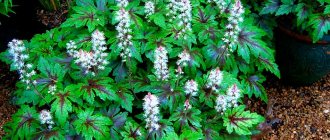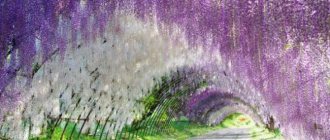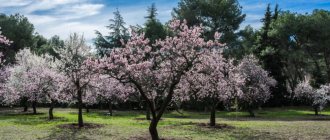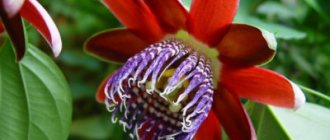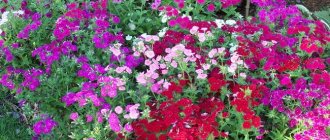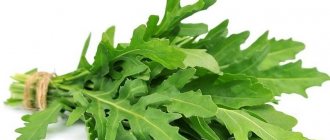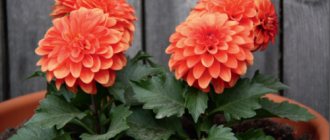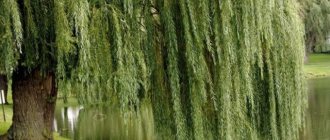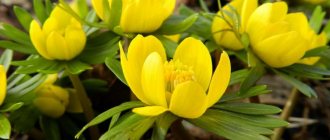Lakfiol or cheiranthus, jaundice, wallflower (Cheiranthus) is a one- or biennial herbaceous flowering plant of the Cruciferous family. It was once very popular, but is now undeservedly forgotten. Lakfiol can become a bright decoration of a flower bed; it will delight you with the cheerful shade of inflorescences, mainly of a warm yellow tone. It is also called yellow gillyflower.
Originally from the Mediterranean, it is found in the Caucasus and the Crimean Peninsula.
The stems are erect, thin, covered with light down, branch weakly, the height ranges from 40 cm to 1 m. The leaves are oblong, located opposite, densely covering the length of the stem, the color is green with a bluish tint.
The flowers are four-petaled, 2-2.5 cm in diameter, collected in large racemes. In addition to various shades of yellow, the tone of the inflorescences can be orange, crimson, or dark red. Flowering is accompanied by a pleasant aroma.
At the end of flowering, a fruit-pod ripens, filled with small light brown seeds (1 g of weight contains about half a thousand pieces).
Growing lacfiol is not particularly difficult. If agricultural practices are followed and minimal care procedures are provided, it will decorate the site for many years.
Growing lacfioli from seeds
Lacfioli seeds of Jaundice cheiranthus photo
Growing jaundice seedlings
You should start sowing jaundice in March, so that after a couple of months you can plant young shoots in open ground. Take a wide container or a special box for growing seedlings and fill it with loose nutrient substrate.
- Distribute the seeds over the surface of the soil, maybe mixed with sand to sow evenly.
- Then moisten by spraying with a fine spray, cover with transparent glass or film on top.
- Maintain the air temperature within 16-18 °C, provide diffused lighting, ventilate the improvised greenhouse daily, and periodically moisten the soil by spraying.
- When shoots appear, remove the cover.
- After the seedlings have formed a pair of true leaves, plant them in separate pots.
Heiranthus growing from seeds photo seedlings
Transplant into open ground with the onset of real warmth (from the second ten days of May). This is how annual species and varieties are grown; perennials are much easier to sow directly into the ground.
Sowing Cheiranthus seeds in open ground
To grow as a biennial crop, the seeds are sown in open ground in May. Dig up the area, spread the seeds over the surface, cover with a rake and water with a watering can.
Lakfiol in open ground transplanting seedlings photo
When the plants sprout, they need to be thinned out, and the excess ones can be transplanted to another place.
In particularly harsh regions in August, it is better to dig up lacfiol, plant it in pots and send it indoors for the winter. Jaundice can only withstand temperatures down to -18 °C. Mature plants are slightly more resistant to cold.
In the southern regions, winter sowing is possible, and the crop also successfully propagates by self-seeding.
Reproduction
The process of crop propagation occurs only by seeds. Collect seed pods no earlier than September and dry thoroughly in cardboard or fabric bags.
Many varieties are capable of self-sowing. The boxes explode, the seeds scatter and instantly take root in the soil. In the southern regions this process is more stable, but in the northern latitudes only a small part of the seeds will be able to germinate next year.
However, seedlings obtained by self-seeding are often susceptible to disease. For example, white rust can often form on it.
https://1decor.org/rasteniya/cvety/lakfiol.htmlhttps://chto-posadit.ru/tsvetok-lakfiol-posadka-i-uhod-v-otkrytom-grunte-vyrashhivanie-iz-semyan-foto-vidov- i-sortov/https://qlumba.com/sad/245-lakfiol
Selecting a site for planting lacfioli
Heiranthus allioni siberian planting and care photo
Lakfiol grows well and develops only in a sunny area without drafts and strong gusts of wind. Do not plant in lowlands or in flooded areas; the close occurrence of groundwater necessitates the construction of a high bed. It is unfavorable to grow in an area where the predecessors are family members.
Regarding the soil: well-drained, nutritious, neutral or alkaline. A couple of weeks before planting, dig up to the depth of a spade and add compost or humus.
LiveInternetLiveInternet
—Categories
- Lyrics (1387)
- Culinary piggy bank (1103)
- Our health: beauty of soul and body (844)
- Lemon note (5)
- Rosemary note (5)
- Cherry note (5)
- Raspberry note (5)
- Lavender note (5)
- Onion note (4)
- Tangerine note (4)
- Orange note (4)
- Bay note (4)
- Plantain (3)
- Castor oil (3)
- Peach note (3)
- Carrot note (3)
- Apple note (3)
- Amaranth note (3)
- Mumiyo (2)
- Blueberry note (2)
- Sea buckthorn note (1)
- Cinnamon note (1)
- Nature and travel (575)
- Rosehip (7)
- Prose (562)
- All about cats (415)
- Parables and legends (329)
- Interesting (245)
- Useful tips (230)
- Music (188)
- Love and loyalty, honor and glory (181)
- My Peter (139)
- Home cinema (108)
- Fashionable things (102)
- New Year (96)
- Childhood Favorites (69)
- Russian cheat sheet (47)
- Art of Dance (43)
- I remember, I'm proud (36)
- Wonders of the world (20)
- French secret (4)
How to care for lacfiol
Jaundice needs regular moderate watering, do not allow waterlogging, short-term drought is better. Focus on precipitation, water as the top layer of soil dries out. Periodically loosen the soil and rid the area of weeds.
In order for lacfiol to bloom magnificently, it is necessary to saturate the soil with nutrients. First, the soil is fertilized before planting, then young plants are fed a couple of weeks after planting (perennials in early spring), and also apply fertilizer during the budding period. Use complex mineral fertilizer or organic matter.
To make the bushes branch better, pinch the tops of the shoots. Trim faded blossoms to speed up the appearance of new buds.
In spring, prune dead shoots (of perennials).
Description of the plant
Heiranthus is an annual plant that delights its owners with beautiful flowers. But you can also find biennial species. They grow as a bush that can grow up to one meter in height. Many gardeners grow varieties that do not reach large sizes.
After some time, the plant blooms, and its flowers can be double-covered, collected in inflorescences. But you can also find regular flowering. Stems are erect, branched. Their surface is covered with bifid hairs. Near the very base the stem becomes woody. The flowers are painted in different colors. They are:
- Yellow
- Pink
- Orange
When the plant blooms, it emits a pleasant aroma. The flowers have an original shape and a yellowish tint, which is why Cheiranthus is often called yellow gillyflower. The appearance of inflorescences begins in early July. The flowering is quite abundant, the smell is often compared to the aroma of lilac. This is an amazing plant that today many gardeners use to decorate their gardens. But it’s worth knowing how to grow cheiranthus correctly so that it pleases with its appearance and flowering.
Diseases and pests of Cheiranthus
Among the diseases we should highlight:
- White rot (or white rust) - the disease affects the stems and leaves, the bushes lose their decorative appearance. It will be necessary to remove the damaged areas and treat with a fungicide;
- Clubroot - it attacks the root system of the plant. Before planting, make sure to lime the soil to avoid problems.
Prevention of diseases is proper care (water moderately, do not overfeed with nitrogen).
The cruciferous or earthen flea beetle is the main and, perhaps, the only pest. To kill the insect, treatment with an insecticide will be required.
Description
Initially, this flower was discovered in the Mediterranean Sea, the Caucasus, and Crimea.
The stems are straight, small in diameter, have fluff, the branches are poorly defined, the height of the plant is usually from forty to one hundred centimeters.
The flowers have four petals, two to three centimeters in diameter, forming large brushes. A distinctive feature of lacfiol is its strong odor. Fortunately, it is quite pleasant and will remind your garden of fragrance.
The seeds have a brown tint and ripen successfully after the end of the flowering period (there are about one and a half thousand seeds per gram of mass).
It is not difficult to grow them and lacfiols will decorate your plot for more than a year in compliance with agricultural technology, which ensures their unpretentiousness and good growth.
Vegetative period
The flowering period of this plant is around May or even April. Depending on the hybrid or variety, it may accommodate.
Lakfiol in landscape design
Lakfiol in landscape design in the photo with soapwort basilicofolia
The best use of lacfiol in a garden plot is planting in a flowerbed in a group, a composition with inflorescences in warm colors pleases the eye and charges with positivity.
Lakfiol and poppies photo
They are also planted in ridges, mixborders, rock gardens, and rocky gardens.
Heiranthus in a flowerbed photo
Low-growing varieties of jaundice are planted in containers, baskets or flower pots. Their purpose is to decorate a veranda, balcony, gazebo, especially since they can be moved from place to place.
Lakfiol and allium photo
Suitable neighbors in the flowerbed will be allium, heliopsis, daffodils, tulips, soapwort, linaria, forget-me-not, Wittrock violet, iberis, poppies.
Heliopsis and lacfiol violet photo
The bright inflorescences of jaundice have a pleasant aroma (it resembles night violet matiola or lilac), it is used to make flower arrangements, the plant is even cultivated for cutting on an industrial scale.
Lakfiol fickle in a flower bed with irises, statice, eremophila and hibiscus fickle photo
History of selection
To develop a new variety, breeders from Finland used:
- knyazhenika (polyaniku) - one of the most delicious berries growing in the northern regions;
- regular raspberries.
As a result of their crossing in 1981, a hybrid Heisa was obtained - nectar raspberry.
Did you know? Raspberries contain large quantities of powerful antioxidants.
—
ellagic acid (or ellagitannins), which helps protect the body from cancer.
Description and characteristics of the variety
The erect shoots of Heisa are rigid, covered with triangular thorns, grow up to one and a half meters in height and form few new branches, which makes harvesting easier. In addition, there is no need to constantly remove young growth.
- Among the advantages of the variety, gardeners note:
- strong pleasant aroma;
- unusual sweet (honey) taste with slight sourness;
- consistently high productivity;
- versatility - the berries are eaten fresh, frozen, juice, elite liqueurs and jam are prepared from them;
- excellent frost resistance (withstands temperatures down to -40°C, i.e. at the level of Arctic berries);
- It does not require special care.
- Minuses:
- The disadvantages of Heisa include the relatively small size of the fruit - up to 4-5 g
According to the description, the berries are bright red in color (see photo), similar in shape to ordinary raspberries (round-conical). Abundant fruiting occurs 3 years after planting. Fruit ripening begins at the end of July and lasts approximately 15 days.
Types and varieties of lacfioli with photos and names
Alpine lakfiol Cheiranthus alpinus
Alpine lakfiol Cheiranthus alpinus photo
The plant is up to 40 cm high, the stems are covered with dark green leaves, the inflorescences are yellow.
Lakfiol Cheri or Wallflower or Zheltushnik Cheri Cheiranthus cheiri
Lakfiol Cheri or Wallflower or Zheltushnik Cheri Cheiranthus cheiri photo
The bushes are about 0.6 m high. The inflorescences have a golden, brownish, dusty red or purple hue.
Lakfiol Allion Cheiranthus allionii
Cheiranthus allionii siberian Cheiranthus allionii photo in a flowerbed
Jaundice Allioni is a hybrid, the inflorescences are large, deep yellow.
Cheiranthus mutabilis
Lakfiol changeable Cheiranthus mutabilis photo
Graceful stems stretch 80 cm in length. The inflorescences have a light yellow tint.
Where can I buy?
| Shop | Variety | Package | Price |
| Auchan | The Snow Queen | 100 pieces | 12 rub. |
| OBI | Moths | 1 g | 20 rub. |
| Compound | Spring song | 0.1 g | 17 RUR |
| Garden Zoo | Spring song | 0.1 g | 11 r |
Lakfiol in the garden
The place in the flower garden for lacfioli depends on what time it will bloom. In the spring garden her partners will be tulips
,
forget-me-nots
,
daffodils
, anemones,
violets
and
primroses
.
Lacfiol, blooming in mid-summer, will successfully coexist with daylilies, phlox, cornflowers
and other perennial crops.
But it is much more effective to use it as a container crop - an elegant flowerpot with fragrant flowers can decorate any corner of the house and garden intended for relaxation: an open veranda, terrace, gazebo, green room, etc. In this case, make a monoplant or line the lacfiol with small-flowered hanging crops - alyssum, lobelia
, laurentia and other flowers (in tone or in contrast).
Bright, cheerful, fragrant cheiranthus will add southern flavor and charm to the calm colors of the short northern summer.
If you liked the article, please share the link with your friends on your social network! Thank you!
